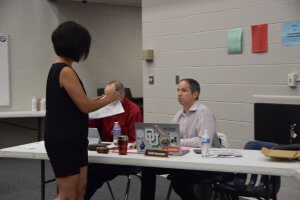The brewing storm rumbling and thundering at 7 a.m. Tuesday was no match for the mood inside Chardon Middle School.
The brewing storm rumbling and thundering at 7 a.m. Tuesday was no match for the mood inside Chardon Middle School.
A Chardon Schools Board of Education subcommittee made up of board members Keith Brewster and Guy Wilson met to determine if an update to the district’s return to school plan requiring students to wear masks was necessary.
Many in attendance argued it was not, including Chardon parent Bonnie Shahan, who said her son has autism and a sensory processing disorder.
“Yes, I’m aware that in most situations, he would be considered exempt from wearing a mask, however, that is not enough. It’s not enough for him,” Shahan said. “He needs to be able to see your face. He needs to see what you’re communicating. When those around him have masks on, he cannot do that. That causes anxiety for him, it causes confusion, it causes him setbacks, total setbacks.”
Shahan said her son has an individualized education plan that includes interacting with peers who model their behavior for him, which is more difficult with masks.
Shahan read off a list of side effects of wearing masks, adding children — especially those under 12 who cannot be vaccinated — may not wear them correctly.
“Kids are gross. They do dirty things, they drop masks, they put them back on. You’re putting dirt on their face and it’s sitting there. That’s gross,” she said.
Geauga Public Health Commissioner Tom Quade was invited to speak to the committee before public comment, as he had to leave by 7:30 a.m., Brewster said.
The audience grew restless during Quade’s presentation — some attempting to interrupt and ask questions. Brewster continually reminded attendees the appropriate time to speak was during the public comment portion of the meeting.
Chester resident Theresa DiNallo questioned the legal ability of school districts to require masks, naming federal laws which prohibit denial of service in business establishments.
“This means you cannot blatantly call students threats and treat people differently based on whether or not they wear a mask, or whether or not they receive the vaccine,” DiNallo said. “This isn’t going to be like Blacks eating on the other side of the restaurant. We are better than dividing ourselves like this.”
DiNallo closed her comments by serving Brewster, Wilson, Superintendent Michael Hanlon and Treasurer Deb Armbruster with an affidavit.
“You, the school board, have been elected to serve this public community and we are requesting that you use good old common sense and do what is best for the children in this district,” she said. “And on that notice, you are being served and hereby put on notice.”
During discussion after the close of public comments, Wilson said he has heard from many parents of high-risk children or those who have other family members at increased risk of severe outcomes from contracting COVID-19, including one who is eligible for a kidney transplant.
They would like their children to return to public schools, he said, but are worried because the district can no longer offer remote learning due to rules from the state legislature.
One member of the audience shouted, “There’s free homeschooling in Ohio,” while Shahan, in the front row, said she and her daughter both have autoimmune risks.
“You do not speak for everybody with autoimmune and high-risk families,” Shahan said. “You do not speak for my family. Ever. Never, ever.”
Brewster, banging the gavel repeatedly, told Shahan he would ask her to leave if she did not stop.
“Okay, ask me to leave,” she replied.
“Please leave the meeting,” Brewster said. “Thank you.”
Several in the audience trickled out after Shahan’s departure, with one commenting the district had “already made up their minds.”
Quarantine Management
Quade presented guidance from GPH, including a quarantine flowchart issued by the Ohio Department of Health.
“We try to remind folks that the mask doesn’t just prevent the disease, the mask helps prevent quarantine,” he said.
Quarantine is not a procedure specific to COVID, but has been used for other disease outbreaks in the past, Quade said.
The GPH recommendations for universal face coverings for students and staff are consistent with recommendations from the U.S. Centers for Disease Control, American Academy of Pediatrics and “every school public health recommendation” Quade is aware of, he said.
“Obviously, there are always exceptions, just like there are exceptions for folks who can’t get the (vaccine) because it’s contraindicated medically. There are folks, we recognize this, for whom a mask may not be appropriate,” he said. “And for those folks that a mask would pose greater problems than it would protection for the population … it’s not, ‘If you can’t wear a mask you can’t come, but if you can wear a mask, you should.’”
However, he added, GPH guidance no longer recommends plexiglass dividers and other physical barriers because the novel coronavirus is primarily transmitted through respiratory spread.
“There’s a tipping point where the more of those hard barriers you have in place — the plexiglass shields and stuff — that you’re adding another surface that would need to be cleaned, you’re adding another touch surface,” Quade said. “If you can’t maintain them to a fairly pristine state, the bang for the buck is maybe not worth it.”
Overall, it’s important to remember some prevention strategies, like the vaccine, protect people, while others — like staying home when ill, covering coughs and sneezes, and wearing masks — can protect others, he said.
“(Wearing a mask) isn’t that much different than covering our cough, right? Nobody’s questioning the reason we cover our cough,” he said. “Does it stop everything? Absolutely not. Does it stop some? Yes, and that’s what we do.”
Mallory Hatmaker, a certified nurse practitioner at Cleveland Clinic, said she has spent the past 18 months diagnosing and treating patients with COVID-19. Her two young children will be entering the Chardon school district this year and are too young to be eligible for a vaccine.
Hatmaker said the U.S. is currently averaging 100,000 COVID-19 cases per day, while that number was as low as 11,000 at the end of June.
Geauga County’s cases per 100,000 residents are higher than surrounding counties, she said. ODH data shows a current case rate of 117.5 per 100,000, with Cuyahoga County at 104.1, Lake County at 95.6 and Ashtabula County at only 56.6 cases per 100,000.
Additionally, Hatmaker said children have made up 15% of the increase in cases across the U.S., with 93,824 pediatric cases reported from July 29 to Aug. 5 and 31% of those hospitalized for severe illness.
“Yes, mortality is low, thank gosh, right? But there’s still urgent concerns,” Hatmaker said, adding the virus may have long-term effects, even in adults, which are not yet apparent.
“If COVID has taught my family one thing in the past 18 months is, it’s just not about us, it’s about the greater good, looking out for public health and complete strangers,” she said.
Hatmaker said cloth masks are not air-tight, but as a barrier, they are one more step to keep children in school.
Additionally, ODH recommendations mean children in a fully-masked classroom no longer have to quarantine if only one child has tested positive for the virus, Hatmaker said.
“The mask is a step,” she said. “I just want kids to stay in school. I think that’s the common ground.”
Unmasking
Allison Zeiger, also a nurse practitioner at Cleveland Clinic, respectfully disagreed with Hatmaker, saying it is “myopic” to think COVID-19 can be eradicated.
“If you asked me how many patients I have actually taken care of, children with COVID, (it was) very few,” Zeiger said. “And to my knowledge, (only) one that was actually ICU-worthy with sickness and that was a 17-year-old.”
Although many cities passed laws requiring masks during the 1918 influenza outbreak, Zeiger said other illnesses that were around long before COVID still circulate and mask mandates were not part of the response to those viruses.
Zeiger said suicide deaths among youths are surging without enough bed space in treatment centers to accommodate children with mental health crises. The district should consult with experts in developmental health in their decision-making, she said.
Chardon parent Kate McGill argued parents should have control over the decision whether or not to mask their children.
As a special educator with a master’s degree in educational administration, McGill said masks have caused setbacks both in her children and those she teaches.
“Children are not learning authentically behind dividers and distanced,” McGill said. “Young learners are unable to be taught to read facial expressions and develop proper speech from lack of visual modeling.”
McGill said she feels masks should be optional, adding there are no long-term studies on masking children, either from a psychological or medical standpoint.
“I will not sit quietly again while strangers without children in this school district make choices that will affect my children for the rest of their lives,” McGill said, adding she had signatures from over 100 parents and Chardon residents who agree.
“We will not allow our children to carry the weight of protecting others on their shoulders,” McGill said. “It is not their responsibility to keep the medically fragile and the elderly healthy. Their sole purpose in life is to focus on their education so that they can become productive members of society.”
Dean Carlo, a local youth minister, opened his comments with three Bible verses.
“Let us, as the above Bible verses say, be sensible, as Proverbs 14 prompts us, that our Chardon young people are created by God and he knows them body and soul, and finally, let’s listen for fear or power and love and sound mind, in their experience of masks,” Carlo said.
He read multiple texts from students he contacted when he heard about the meeting, describing their discomfort wearing masks.
Carlo closed with another verse.
“Jesus said in Matthew 18, ‘If anyone causes one of these little ones to stumble, it would be better for them to have a large millstone hung around their neck and to be drowned in the depths of the sea,’” Carlo read. “Woe to the world because of the things that cause people to stumble. Such things must come, but woe to the person through whom they come.”
The meeting can be viewed in its entirety here.
The full board of education will meet Aug. 16 to consider any recommendations from the subcommittee.


















